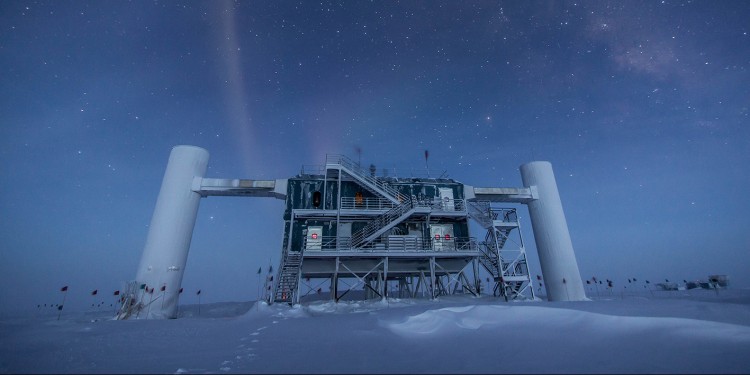
"Neutrinos are very difficult to detect"
Researchers from several countries are using the IceCube experiment to search for neutrinos in the ice at the South Pole. These difficult-to-detect particles reach Earth from the cosmos. About 220 of the physicists involved in the experiment meet for the first time at the University of Münster from 18 to 22 March for the spring meeting of the IceCube collaboration. The meeting is hosted by Prof Alexander Kappes and his working group at the Institute for Nuclear Physics at the University of Münster. On this occasion, Christina Hoppenbrock interviewed the spokesperson of the IceCube collaboration, Prof Ignacio Taboada from the Georgia Institute of Technology, USA, about the challenges of neutrino research and the progress of the experiment.

Twice a year, the collaboration meets to discuss progress on research with IceCube. The spring meeting is hosted by Alexander Kappes and his group in recognition of their leading role within IceCube and the proposed IceCube-Gen2.
Neutrinos are also known as "ghost particles". What is so mysterious about them?
Neutrinos are very hard to ‘catch’. A good example is a pane of glass. Glass is transparent to light. Most of the light goes through it – but not all. If you look at a pane of glass edgewise, you see that it has a green tint. This is because of the light that has ‘interacted’ in the glass. To neutrinos matter is transparent, just like for light glass is transparent. But to stop a few neutrinos a pane of glass is not enough, instead you need gigantic detectors. IceCube is one cubic kilometer, the volume of a small mountain, so that we can catch the very few neutrinos that do interact.
How does that work exactly?
The neutrinos that interact with matter produce new particles. These particles travel through ice near the speed of light and produce blue light, called Cherenkov radiation. We observe neutrinos with optical sensors, called Digital Optical Modules (DOM), that capture this blue light. Knowing when light was captured at a DOM and how much light (it can be as little as one photon), lets us know the direction from where the neutrino came from and the energy of the neutrino.
In the past two years, the IceCube consortium has published two widely regarded articles in the journal "Science" …
In November 2022 we reported 79 neutrinos recorded in over nine years of observations from the galaxy NGC 1068. Amateur astronomers may know this galaxy a Messier 77 and it can be seen with binoculars. The distance to it is 47 million light years. This sounds enormous, but NGC 1068 is actually nearby, according to cosmic scales. What makes me most excited about the NGC 1068 observation is that neutrino emission appears to be “steady”. If we doubled the observation time, we should be able to roughly double the number of neutrinos that we have observed from NGC 1068. This increase in the number of neutrinos will enable us to understand the processes at NGC 1068 that generate the neutrinos. It is believed that these neutrinos are created near a supermassive black hole at the center of NGC 1068, but many details are unclear.
And what was the second article about?
In June 2023 we reported the observation of our own galaxy, the Milky Way with neutrinos. The Milky Way is expected to have neutrino sources – probably the remains of past supernova explosions. And the galaxy is filled with cosmic rays (created in the same remains from supernovae explosions), which are protons, helium nuclei and heavier nuclei. Both neutrino sources in the Milky Way and the propagation of cosmic rays through the galaxy result in neutrinos detectable by IceCube. Currently we can’t separate individual sources from the propagation of cosmic rays in the galaxy. But we look forward to solving that question.
... like many other questions, right?
That's right. The IceCube-Gen2 observatory with a volume eight times larger than that of IceCube has been proposed as a successor. Gen2 will enable the observation of not just two galaxies, but possibly two dozen galaxies. And It would have significant enhanced sensitivity to higher energy neutrinos by adding radio antennas to the optical sensors.
About the IceCube project:
The IceCube Neutrino Observatory is located at the Amundsen-Scott South Pole Station. The observatory is managed and operated by the Wisconsin IceCube Particle Astrophysics Centre at the University of Wisconsin-Madison. The IceCube collaboration counts over 400 hundred physicists that use data from the Observatory, to study the Cosmos with neutrinos. Major accomplishments by the collaboration include the discovery of astrophysical high-energy neutrinos, the observation of neutrinos from two galaxies and the observation of our own galaxy, the Milky Way, with neutrinos.
After the USA, Germany is the most important partner in IceCube. The universities of Aachen, Berlin (Humboldt University), Bochum, Dortmund, Erlangen-Nuremberg, Mainz, Munich (Technical University), Münster and Wuppertal, as well as the Helmholtz centres Deutsches Elektronen Synchrotron DESY and the Karlsruhe Institute of Technology (KIT) are involved.
